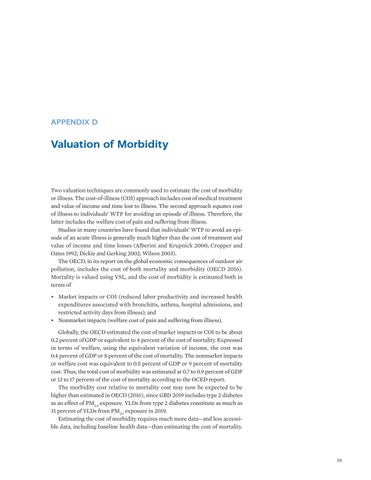APPENDIX D
Valuation of Morbidity
Two valuation techniques are commonly used to estimate the cost of morbidity or illness. The cost-of-illness (COI) approach includes cost of medical treatment and value of income and time lost to illness. The second approach equates cost of illness to individuals’ WTP for avoiding an episode of illness. Therefore, the latter includes the welfare cost of pain and suffering from illness. Studies in many countries have found that individuals’ WTP to avoid an episode of an acute illness is generally much higher than the cost of treatment and value of income and time losses (Alberini and Krupnick 2000; Cropper and Oates 1992; Dickie and Gerking 2002; Wilson 2003). The OECD, in its report on the global economic consequences of outdoor air pollution, includes the cost of both mortality and morbidity (OECD 2016). Mortality is valued using VSL, and the cost of morbidity is estimated both in terms of • Market impacts or COI (reduced labor productivity and increased health expenditures associated with bronchitis, asthma, hospital admissions, and restricted activity days from illness); and • Nonmarket impacts (welfare cost of pain and suffering from illness). Globally, the OECD estimated the cost of market impacts or COI to be about 0.2 percent of GDP or equivalent to 4 percent of the cost of mortality. Expressed in terms of welfare, using the equivalent variation of income, the cost was 0.4 percent of GDP or 8 percent of the cost of mortality. The nonmarket impacts or welfare cost was equivalent to 0.5 percent of GDP or 9 percent of mortality cost. Thus, the total cost of morbidity was estimated at 0.7 to 0.9 percent of GDP or 13 to 17 percent of the cost of mortality according to the OCED report. The morbidity cost relative to mortality cost may now be expected to be higher than estimated in OECD (2016), since GBD 2019 includes type 2 diabetes as an effect of PM2.5 exposure. YLDs from type 2 diabetes constitute as much as 31 percent of YLDs from PM2.5 exposure in 2019. Estimating the cost of morbidity requires much more data—and less accessible data, including baseline health data—than estimating the cost of mortality.
55

